Geographic Information System (GIS)
How can geospatial data be used to integrate environmental considerations into humanitarian response

How can geospatial data be used to integrate environmental considerations into humanitarian response
This resource provides multi-layered satellite imagery with open-access data including roads, type of built-up areas etc that can help identify potential environmental hotspots.
A platform with free access to ESA and NASA low resolution (10m) satellite imagery that is updated weekly and can help identify environmental changes published by Sinergise.
The PREVIEW Global Risk Data Platform by UN Environment and UNISDR is a multiple agencies effort to share spatial data information on global risk from natural hazards. Users can visualise, download or extract data on past hazardous events, human & economical hazard exposure and risk from natural hazards.
GeoQ is a web-based tool that fuses together data about a disaster site, including maps, imagery, news videos, and even social media from citizens at the scene.
Earth-i provides very high resolution satellite data and processing services to organizations and agencies managing disaster response in natural and urban environments; identifying, preparing and planning for potential threats and emergencies; and responding rapidly to events as they occur.
The UNITAR Operational Satellite Applications Programme (UNOSAT) provides high-quality geo-spatial information to UN decision makers, member states, international organizations and non-governmental organizations.
The Humanitarian Data Exchange (HDX) is an open platform for sharing data across crises and organisations…
This study, conducted in 2020, sheds light on a variety of potentials and pitfalls of remote sensing for disaster risk analyses in fragile contexts. This topic gains importance in light of the need to formulate more systemic and better-integrated approaches to risk-informed development. Evidence-based policy recommendations encourage organizational learning and…
Copernicus is the European Commission's Earth Observation Programme with vast amounts of global data from satellites and from ground-based, airborne and seaborne measurement systems.
A cloud solution for mapping and monitoring the sustainable use of natural resources.